
110 Cookson Lane | Whitefield, ME 04353 | 207-232-7600 | tim@lackeysailing.com
With the saw now back in operation, I continued work on the toerail. I milled a new section of mock toerail from a length of scrap 2x4, and after a few more head-scratching moments considering the jig I'd built before the saw died last week, I eventually determined that it would indeed work the way I wanted, though only for one side of the boat. I'd have to reverse the angle on the jig in order to cut the second side and keep the scarfs running in the same direction (points facing aft). If the toerail blanks had been square, instead of angled on one face, I could have flipped the blanks instead.
In any event, once I figured this out, the process went smoothly, and I was grateful for the extra time it'd taken for me to finally get to this point. Beginning with my mock toerail section, which I cut into two 4' long lengths, I milled two conjoining cuts, simulating one joint in the toerail. I was pleased with the accuracy of the cut, and also used the experience to determine exactly how to align the boards with the cutline in the jig for best results.
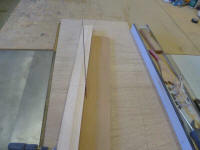

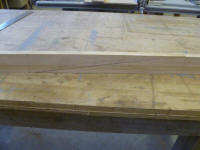
I set up the first length of teak toerail in the jig; the way the jig was set up, I had to start with the starboard rail. To help support the jig and the toerail length, I moved a work table that normally resided several feet away to a position just behind the saw, which allowed the plywood jig to be supported as I set up the teak within. I also had to support the far end of the teak rail. I made the first cut, then its complementary cut on the next board length, and tested the fit.

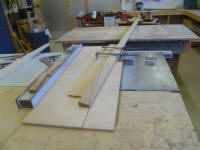
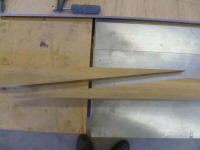
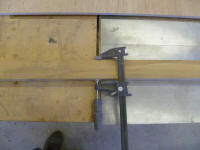
In this way, I continued through the remaining cuts in the starboard rail sections, checking each set of cuts to ensure they were aligning properly.
With the starboard side compete, I reversed the angled board on the cutting jig so I could cut the scarfs in the port rail. This was straightforward with a bevel gauge, and with the saw kerf already cut in the plywood jig base and fence. After creating a test joint in my 2x4 toerail, I cut all the scarfs in the port rail sections, following the same processes described above.
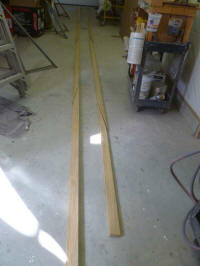
Using a long tape, I measured each overall length and marked the final section where I could cut off the excess, at about 36' (I needed a minimum of 34 conjoined feet on each side--already a conservative (extra-long) figure, and I added the additional margin just to be sure. I would cut the rails to exact length at the transom after final installation.
After cleaning the joints thoroughly with acetone, and laying plastic sheeting on the floor, I prepared for gluing by first applying a coat of unthickened epoxy to each surface, and letting it set up for a bit. Then, I applied some slightly thickened epoxy to each joint, and clamped them securely, one at a time and ensuring that the joints were properly aligned in all directions.


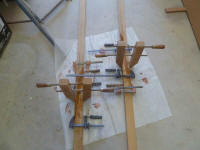
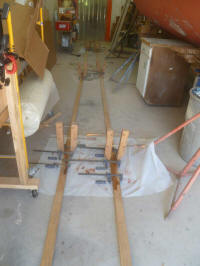
I'd leave the toerail in the clamps through at least one entire day, to give the epoxy plenty of time to cure and gain ultimate strength, so I'd not look at the toerail again till Wednesday anyway.
Back in the boat, I completed a couple odds and ends and lightly sanded the primer coat on the bulkheads around the galley, and also sanded the eyebrow trim to prepare each respectively for their next coats. after cleaning up, I revarnished the eyebrow, and applied the first coat of semi-gloss white enamel to the galley areas.
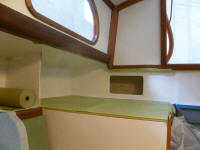

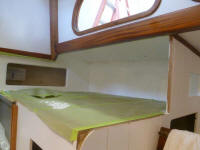
Now that my saw was back in action, I could begin work on some of the interior trim needed in the new galley. I began with the companionway ladder, as I was looking forward to a real means of ingress rather than my creaky construction ladder. After consulting some notes I'd made on the ladder spacing, I milled two side boards from mahogany, then laid out the locations for the two steps on this portion of the ladder (the third step being the top of the engine box). I milled grooves at each of these locations to accept the steps, then cut an angle on the forward face to create the necessary angle for the ladderway.
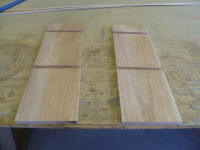
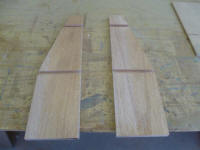
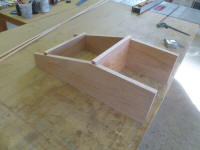
After cutting two steps to fit, I rounded the corners of the new pieces as necessary, and sanded all areas smooth through 220 grit. Then, I secured the steps in place with glue and screws. Because there wasn't sufficient thickness of material outside of the grooves to support a screw and leave room for a countersink and bung, I simply installed the bronze screws flush with the surface.
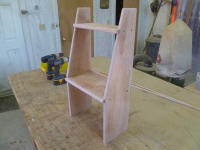
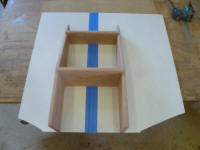
Later, I'd install this ladder directly to the front face of the engine room, roughly as shown. First, though, I'd varnish the ladder.
Total Time Billed on This Job Today: 8 hours
<Previous | Next>
